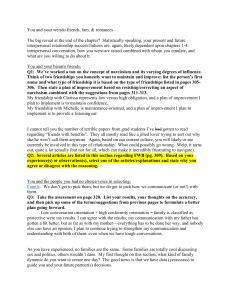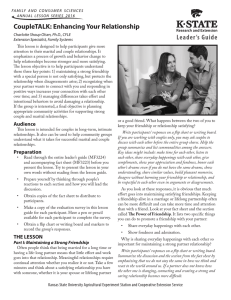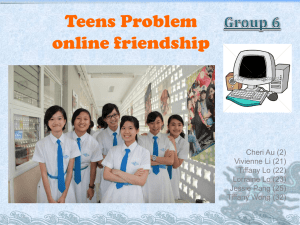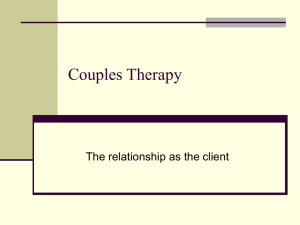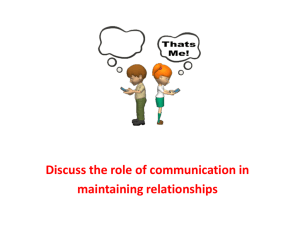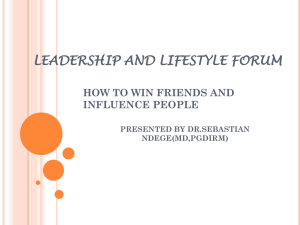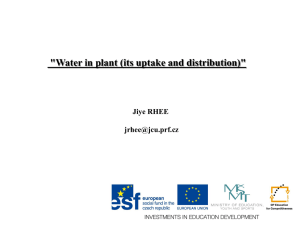Powerpoint - Presentation April 18
advertisement
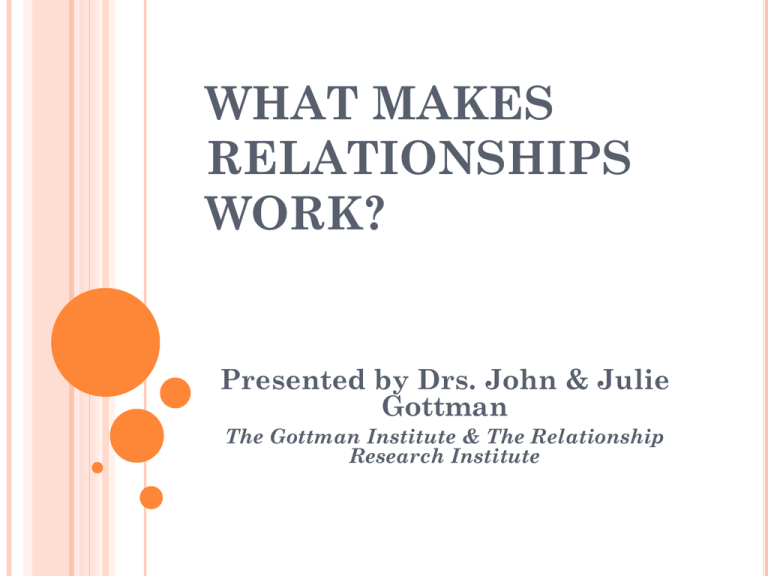
WHAT MAKES RELATIONSHIPS WORK? Presented by Drs. John & Julie Gottman The Gottman Institute & The Relationship Research Institute GOTTMAN RESEARCH AND METHODS Over 40 years of academic research begun in 1972. Started in 1976 working with Dr. Bob Levenson Observed over 3,000 couples in research “The Love Lab” (apartment lab) The importance of physiology The “masters” and “disasters” of relationships Our Research Methods • • • • • • • • • • 40 Years of Research, Representative Samples, Happy-Stable, Not Only Ailing Relationships Multi-Method: Physiology, Self-Report, Behavior Multi-Situational: Conflict, Events, Apartment Lab Longitudinal (Up to 20 Years) and Developmental (Babies, Children) Gay, Lesbian, as Well as Heterosexual Domestic Violence 3Transition to Parenthood Theoretical and Mathematical Intervention and Prevention Research Section 1.2 Extension to Lower-income Populations THE LEVENSON-GOTTMAN VIDEO-RECALL RATING DIAL VALIDITY OF BEHAVIOR CODING THREE LINKED PHASE SPACES: TIME SERIES 60 Behavior 40 20 0 -20 H behavior -40 W behavior -60 30 20 Perception 10 0 -10 W perception H perception -20 -30 60 Physiology 40 20 0 -20 -40 -60 W physiology H physiology WHAT PREDICTS DIVORCE? Ratio of positive to negative emotions in conflict Couples in happy, stable relationships: 5:1 ratio of positivity to negativity when discussing an area of disagreement 20:1 ratio of positivity to negativity when simply conversing Even when talking about an area of continuing disagreement, “masters” demonstrate affection, humor and interest in each other. They minimize defensiveness in partner. ARE ALL NEGATIVE INTERACTIONS EQUALLY CORROSIVE? Some ways of interacting are more corrosive to a relationship than others. We call these: THE FOUR HORSEMEN OF THE APOCALYPSE …………………….. WHAT DO HAPPILY MARRIED COUPLES LOOK LIKE? THEY…. Have positive everyday interactions and behave like good friends, turning toward one another. Handle their conflicts in gentle, positive ways; have more positive affect during conflict to soothe partner and co-regulate physiology. Are able to repair negative interactions during an argument. Have greater sense of “we-ness” than “me-ness” and purpose in life. Are able to effectively share and discuss negative emotions with each other. This is all interesting and predicts divorce or stability with over 90% accuracy across studies. But it doesn’t help us change couples. Need a theory. THE SOUND RELATIONSHIP HOUSE THEORY A new approach to couples’ therapy Derived from our basic longitudinal research The focus is on: - Emotion: The “engine” of change - Skills to enhance friendship - Skills to manage conflict - Skills to create shared meaning NEWEST RESEARCH IS ABOUT TRUST IN RELATIONSHIPS THE GOAL was to define trust and betrayal as valid metrics, Which could be computed in any one couple’s interaction (in any social context) Trust not conceptualized as a trait but as a characteristic of an interaction. Define metrics to measure trust and betrayal on a micro level. So we can understand temporal DYNAMICS and create preventions and interventions. How to do that? GAME THEORY. NURTURE FRIENDSHIP AND INTIMACY The first three levels of the Sound Relationship House focus on a couple’s friendship, which is the foundation of a strong relationship. FRIENDSHIP: BUILD LOVE MAPS Maintain an awareness of each other’s world Show interest in each other by asking open-ended questions, and remember the answers FRIENDSHIP: SHARE AND NURTURE FONDNESS AND ADMIRATION Create a positive habit of mind by looking for what your partner is doing right. Express fondness and admiration to each other verbally and physically. Build a culture of appreciation, fondness, affection and respect. FRIENDSHIP: TURN TOWARD EACH OTHER Express needs by stating what you do want, not what you don’t want. Turn towards each other’s bids for emotional connection, rather than away or against them. Build an emotion bank account POSITIVE PERSPECTIVE: THE SENTIMENT OVERRIDES When the first three levels of The Sound Relationship House work well, a relationship contains the Positive Perspective, or in general, positive feelings for one another that OVERRIDE momentary negativity. Partners are more likely to give each other the benefit of the doubt. MANAGE CONFLICT CONSTRUCTIVELY Practice self-soothing to keep calm; take breaks. Process Regrettable Incidents and Past Emotional Injuries. Use softened startup. Repair and de-escalate. Accept influence – find common ground. Compromise. 69% of all issues are PERPETUAL: Discuss perpetual problems - move from gridlock to dialogue by focusing on the existential meaning of each person’s position on the issue MAKE LIFE DREAMS COME TRUE Make the relationship save enough so that each partner can express his or her dreams. Using the skills of accepting influence and compromise, partners can nurture each other’s dreams while maintaining their own. CREATE SHARED MEANING Create meaningful rituals of connection: formal & informal Create shared meaning for relationship by expressing values, roles, goals, and narratives. Share ideas about legacy and meaning in order to create shared cultural rituals and purpose. CLINICAL WORK BASED ON THE SOUND RELATIONSHIP HOUSE THEORY Very specific assessment of a relationship: its strengths and areas that need improvement EMPIRICALLY BASED COUPLES’ THERAPY: We have blueprints for: (1) building Friendship/Positive Affect/Intimacy, (2) Blueprints for conflict, and (3) Blueprints for building shared meaning. PSYCHO-EDUCATIONAL: Two-day “Art & Science of Love workshop. PREVENTION: Transition to parenthood workshop “Bringing Baby Home.” TREATMENT OF DOMESTIC VIOLENCE. Group treatment of situational violence. EMOTION COACHING FOR CHILDREN. THANK YOU FOR LISTENING
